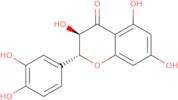
(+/-)-Taxifolin
CAS: 24198-97-8
Ref. 3D-FT28010
| 1g | 705,00 € | ||
| 2g | 1.071,00 € | ||
| 5g | 1.607,00 € | ||
| 250mg | 300,00 € | ||
| 500mg | 443,00 € |
Produktinformation
- Dihydroquercetin3,3',4',5,7-Pentahydroxyflavanone hydrate
- (?à)-Dihydroquercetin
- (?à)-Taxifolin
- (±)-Dihydroquercetin
- (±)-Taxifolin
- 4H-1-Benzopyran-4-one, 2-(3,4-dihydroxyphenyl)-2,3-dihydro-3,5,7-trihydroxy-, trans-(±)-
- 4H-1-Benzopyran-4-one,2-(3,4-dihydroxyphenyl)-2,3-dihydro-3,5,7-trihydroxy-, trans-(?à)- (8CI)
- rel-(2R,3R)-2-(3,4-Dihydroxyphenyl)-2,3-dihydro-3,5,7-trihydroxy-4H-1-benzopyran-4-one
- 4H-1-Benzopyran-4-one, 2-(3,4-dihydroxyphenyl)-2,3-dihydro-3,5,7-trihydroxy-, (2R,3R)-rel-
Taxifolin is a natural compound that belongs to the class of flavonoids, which have shown hypoglycemic effects in experimental models. Taxifolin promotes apoptosis by inhibiting the expression of the BCL-2 protein. This protein inhibits apoptosis by binding to the pro-apoptotic proteins, such as p53 and Bax. Taxifolin also has anti-inflammatory properties due to its inhibition of prostaglandin synthesis. The optimum concentration for taxifolin is between 1 and 5 μM. It also binds to DNA-binding response elements, which may affect gene transcription. The rate constant for this process is approximately 10^(-4) M^{-1} s^{-1}. Taxifolin has been shown to be effective against dextran sulfate sodium (DSS)-induced inflammation in vivo, which may be due to its ability to inhibit postprandial blood glucose levels at a concentration of 5 mg/kg body weight.
Chemische Eigenschaften
Technische Anfrage zu: 3D-FT28010 (+/-)-Taxifolin
Wenn Sie ein Angebot anfordern oder eine Bestellung aufgeben möchten, legen Sie stattdessen die gewünschten Produkte in Ihren Warenkorb und fordern Sie dann ein Angebot oder eine Bestellung an aus dem Warenkorb. Es ist schneller, billiger und Sie können von den verfügbaren Rabatten und anderen Vorteilen profitieren.





